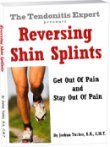Acutely painful small lump on Achilles tendon
by Jonathan Small
(Southam, Warwickshire, UK)
I am a Podiatrist in the UK who has seen a patient referred by an Orthopaedic Foot Surgeon for an acutely painful lump on his left Achilles tendon. The lump is maximum 5mm in diameter and located over the middle of the tendon approx. 3cm proximal to the calcaneal enthesis.
It has been present for 6 months, and the patient suspected a cyst. It can hurt at anytime, even in bed at night, and is not apparently linked to activity levels.
It is intense pain that temporarily prevents continued weight-bearing, but eases spontaneously after just 2 minutes.
The surgeon categorically states that there is no evidence of cyst or Achilles ruptures on ultrasound scan. He wondered if there was a biomechanical cause, hence referral to myself.
However, my assessment revealed no gross abnormalities except bilaterally externally rotated hips and mild forefoot varus causing mildly excessive pronation in the sub-talar joint during midstance phase of gait.
Unlike the surgeon, I found a test that did illicit the symptoms in full - namely static repeat heel raises with knee straight as I was testing gastroc power.
The only time I have seen symptoms like it is in acute injury situations, but those symptoms don't subside spontaneously after just a couple of minutes!
The lump is tender when palpated, but not as painful as the test induced. It does not move or float.
Apparently 15+ years ago, the patient did damage an Achilles tendon playing sport, but does not know which one. The left tendon does appear thickened compared to the right.
This appears to be an unusual case. My online research suggests tendonosis, but the surgeon thinks tendonitis. I'd be grateful for your thoughts.
----
Joshua Answers:Hi Jonathon. It'd be happy to add whatever I may to the investigation.
Working on the assumptions that there is no cyst, no tumor, no significant rip/tear, nothing else medical that would have shown up on ultrasound, here's my thoughts.
1. So 5mm is about the size of a pea. Which to me means that there was a specific site of tiny rip/tear, and over time the body has laid down scar tissue. Microscopic tears to that new scar tissue structure and the body lays down more scar tissue. Over and over until there's a nodule of scar tissue.
The nervous system reads this as an ongoing injury, and treats it as such.
2. Static strain results in pain that goes away quickly. But also hurts other times, like in bed at night.
Acute injury pain doesn't go away that fast, as you say. But, for instance, bad shin splints can -force- a runner to stop running due to
the pain, and then not hurt a couple minutes later.
It's quite possible that the same dynamic is in place here. There's definitely pain enhancing chemical from the inflammation process in place, but as the nervous system also plays a role, if it thinks there is danger, it can create pain to make you stop doing the dangerous activity.
I would think the pain from static strain that goes away quickly is more a function of the nervous system trying to avoid injury to a structure it is concerned about.
And of course, everybody and their pain is a little different, what you've described doesn't surprise or concern me.
And the pain at night is (probably) basically from the near constant release of pain enhancing chemical due to chronic, tiny injury as every day, every step has the potential to rip one of those microscopic scar tissue fibers and set the whole thing in motion again.
3. There could be some
Tendonosis involved, there usually is with
Achilles Tendonitis, but it sounds more consistent with the above.
4. For specific spots like this, specific massage on the tendon. I would have the client:
A. Ice massage the tendon itself frequently throughout the day, and/or
B. Just massage with finger tip. Across the fibers, circles, compressions, however one wants to do it.
Essentially, that nodule is a dry, fragile, crunchy sponge. Rub it enough and it will reshape into a soft, mobile, gummy sponge.
When it's fragile it gets frequent microscopic reinjury. When it's gummy and mobile, it structurally isn't as prone to that frequent reinjury.
There are other factors at play, of course, but one HAS to restucture that nodule. It likely won't go away, but it doesn't need to vanish, it just needs to be more squishy/gummy and less dry/crunchy/fragile.
I know that's highly technical lingo there....:)
(p.s. you submitted this on the public forum so I'll assume it's fine to post for all to see/learn from.)
----------------------
Please reply using the comment link below. Do not submit a new submission to answer/reply, it's too hard for me to find where it's supposed to go.
And, comments have a 3,000 character limit so you may have to comment twice.
----------------------- 
Joshua Tucker, B.A., C.M.T.
The Tendonitis Expert
www.TendonitisExpert.com
- Home
Tendonitis
Still Tendonitis
Related Reversible Problems
Site Pages
-
Sep 01, 25 04:38 PM
If you have Wrist Tendonitis you may/may not have Carpal Tunnel Syndrome. They aren't the same thing. Tendonitis of the wrist tendons is reversable and fixable.
Read More
-
Aug 29, 25 06:28 PM
Dequervains Tendonitis is a fancy term for Tendonitis of the Thumb. It is NOT a disease. Dequervains tenosynovitis is very related. Ok, it's the same thing.
Read More
-
Aug 29, 25 06:18 PM
Have Achilles Tendonitis and/or Achilles Tendonosis repetitive strain injury? Effective Achilles Tendonitis Treatment gets you on your feet, pain free.
Read More




